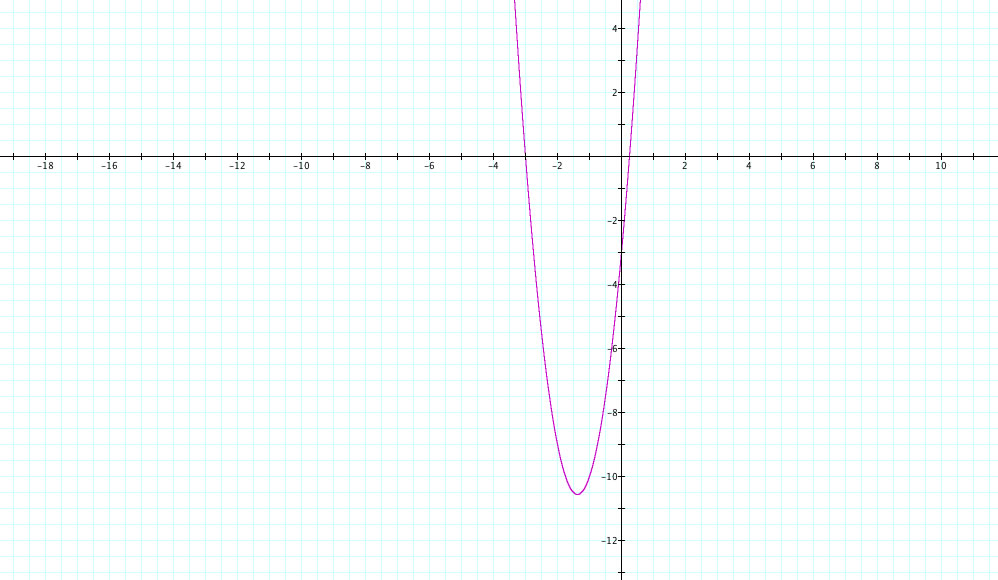

Make up linear functions f(x) and g(x). Explore, with different pairs of f(x) and g(x) the graphs for h(x) = f(x) +g(x), h(x) = f(x)*g(x), h(x) = f(x)/g(x), and f(g(x)).
1. h(x) = f(x) + g(x)
f(x) = 2x+5 g(x) = 5x+7
The graph below shows what occurs when one graphs h(x) = f(x) + g(x). In this case, h(x) becomes 7x + 12.
As can be seen in this graph, the simple act of adding linear functions results in another linear function. Looking at the "visual steepness" of the graph, it appears that the line has a much more vertical tendency to it. Alas, the slope of the function has changed two seven, the sum of the slope 2 from f(x) and the slope 5 from g(x). This does not seem to shocking. In a similar fashion, the y-intercept of the sum is the sum of the y-intercepts of f and g (In this case, 7+5 = 12). Although this does have some good properties to look at, the following operations on functions are much more interesting.
2. h(x) = f(x)*g(x)
f(x) = 4x-1 g(x) = x+3
The image below shows what happens when graphing the product of these two function, where h(x) = (4x-1)(x+3) = 4x2 + 11x -3.

As you can see, a function that is the product of two linear functions is a quadratic function, taking the shape of a parabola. In this case, the values from the original two functions affect many of the characteristics of the resulting parabola. I will discuss more about the a, b, and c of the general form of ax2+bx+c in future write ups. However, in general, two functions, f(x) = cx+d and g(x) = mx+n result in an h(x) = (cm)x2 + (dm+cn)x + dn. Thus the two original functions chosen can have a great effect on the resultant parabola when multiplied together. For instance, if you start out with one function that has a negative slope and another that has a positive slope, you will end up with a graph that is concave down, since (cm) would result in a negative value. Again, more discussion on the characteristics of quadratics later. It is just important to realize that the values chosen for the coefficients in the original linear functions will effect the product. One fact that one is assured of is that the quadratic will have 2 real roots and no complex roots, due to starting out with two linear (real) functions.
3. h(x) = f(x)/g(x)
f(x) = 5x-6 g(x) = -3x+1
The following graph displays what happens when the function f(x) is divided by g(x) resulting in h(x) = (5x-6)/(-3x+1).
Here, what we have, with h(x) = f(x)/g(x) is what we sometimes call a "rational" function, because it takes the form of a polynomial over a polynomial. However, this graph has a very different look than many we study in school. It appears to have two "different parts." It is very light in the image, but you can see the dotted line between 0 and 1, which many would call an asymptote. This occurs at x = 1/3. This is where the lone singularity (i.e., where the rational function doesn't exist) of the function appears. As we know, anything divided by zero is undefined, so when -3x+1 = 0. we will have a singularity. Solving for x we get 1/3. Thus, as x approaches 1/3 from the right, we see the function tending towards infinity. This is because we have the denominator of the function getting smaller and smaller, resulting in a larger number overall. As x approaches 1/3 from the left, the same thing occurs, except y tends towards negative infinity.
As one will notice, for most x, the output will be negative. This is obvious if one looks closely at the functions in the numerator and denominator. When x is positive, in most cases the denominator will be negative and the numerator will be positive, resulting in a quotient of a negative value. Conversely, when x is negative, in most cases the denominator will be positive while the numerator will be negative. Again, this will depend on the functions chosen for f and g, and how they tend to negative or positive outputs.
4. h(x) = f[g(x)]
f(x) = -4x-1 g(x) = 1/2x+3
For our final exploration, I explore what happens in the composition of f and g, h(x) = f[g(x)] = -2x-13.
It is obvious immediately that it seems like the composition of two linear functions results in a linear function. From high school, we know that if the composition had resulted in h(x) = x, then the two would be inverses of each other. However, this is not the case and we see that at the very least these two are not inverses of one another. Other information can also be gleened from viewing the graph. Again, it appears like the composition results in the multiplication of slopes. The slope of f was negative 4, and the slope of g was positive 1/2, resulting in a slope of negative 2 in our composition graph. The Y intercept became -13, which is the product of f's slope and g's y-intercept, added to f's y-intercept. Ultimately this graph became less interesting on the whole than the product or division result!